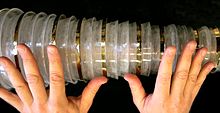
Back Şüşə armonika Azerbaijani Гласхармоника Bulgarian Harmònica de vidre Catalan Skleněná harmonika Czech Glasharmonika Danish Glasharmonika German Vitroharmoniko Esperanto Armónica de cristal Spanish Beirazko harmonika Basque آرمونیکا Persian


The glass harmonica, also known as the glass armonica, glass harmonium, bowl organ, hydrocrystalophone, or simply the armonica or harmonica (derived from ἁρμονία, harmonia, the Greek word for harmony),[1][2] is a type of musical instrument that uses a series of glass bowls or goblets graduated in size to produce musical tones by means of friction (instruments of this type are known as friction idiophones). It was invented in 1761 by Benjamin Franklin.
- ^ Harper, Douglas. "harmonica". Online Etymology Dictionary. Harper, Douglas. "harmonic". Online Etymology Dictionary.
- ^ ἁρμονία. Liddell, Henry George; Scott, Robert; A Greek–English Lexicon at the Perseus Project.